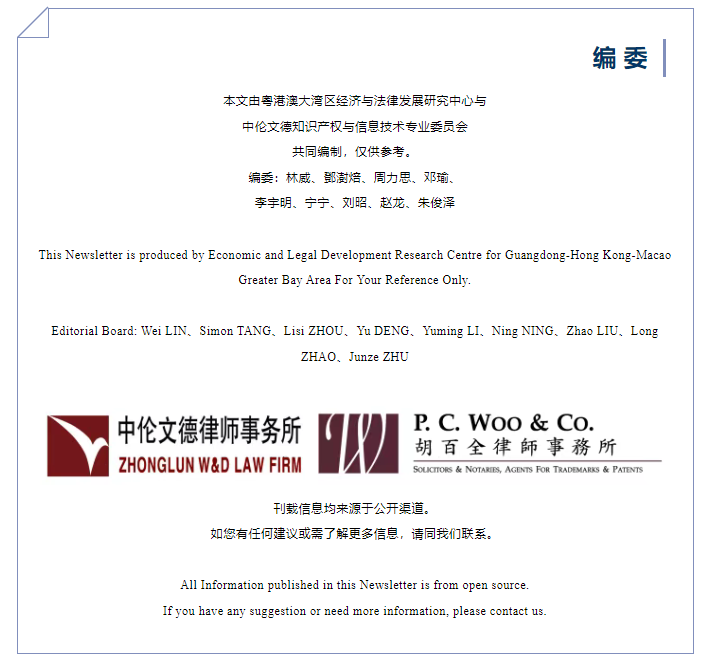
NEWS

NEWS

Jiangsu issues the nation's first overseas intellectual property protection guidelines for the biopharmaceutical sector
Recently, Jiangsu issued the nation's first overseas intellectual property protection guidelines for the biopharmaceutical sector, filling a domestic gap in guidance for Chinese biopharmaceutical companies expanding overseas. These guidelines provide systematic, professional, and comprehensive guidance on overseas IP protection for China's "going global" biopharmaceutical enterprises.
Focusing on industry-specific characteristics, the guidelines comprehensively outline international IP protection treaties for biopharmaceuticals, market access and regulatory requirements in five major countries, and enumerate common IP risks—particularly those unique to the sector, such as patent term extension, patent linkage systems, and drug test data protection.
By analyzing 18 typical biopharmaceutical IP cases, the guidelines interpret key protection points and risk mitigation strategies in target countries and regions. Additionally, they compile 70 links to full texts of biopharmaceutical IP laws and regulations across 12 countries and regions, along with a list of 93 overseas IP service institutions.
ZLWD Commentary:
The guidelines refine fragmented international rules, cases, and practical experiences into standardized operational guides. They provide actionable operational guidance and risk lists for differentiated rules specific to the biopharmaceutical sector, such as patent term extension calculations, drug test data, and patent linkage systems.
The CPC Central Committee issued the Opinions of the CPC Central Committee on Strengthening Judicial Work in the New Era
In the section titled “Improving the Rule-of-Law-Based Business Environment”, the Opinion calls on the people’s courts to enhance the punitive damages regime in the field of intellectual property, strengthen the regulation of monopolistic and unfair competition practices, and safeguard fair market competition.
In the section on “Strengthening Intellectual Property Adjudication”, it is stated that the people’s courts shall intensify judicial protection of technological innovation and trade secrets in key and emerging areas. The courts are also expected to fully leverage the adjudicatory functions of intellectual property trials, improve the appellate review mechanism for IP cases, and refine the coordination between administrative enforcement and judicial adjudication in the field of intellectual property, thereby promoting comprehensive governance in this area.
In the section on “Enhancing Adjudication in Foreign-Related and Hong Kong, Macao, and Taiwan-Related Cases”, the Opinion urges the people’s courts to strengthen international judicial exchanges and cooperation, and actively participate in the formulation of international rules in areas such as international trade, intellectual property, environmental protection, and cyberspace. Additionally, in the section on “Deepening and Standardizing Judicial Transparency”, the Opinion requires the people’s courts to continue advancing the disclosure of judicial information, including rulings, court hearings, and trial procedures, on a regular basis. Courts are also encouraged to routinely release judicial statistics, further diversify disclosure formats, improve the quality of judicial transparency, and enhance the overall transparency framework.
ZLWD Commentary:
This Opinion reflects the central government's strong emphasis on enhancing the modernization of the judicial system, particularly through strengthened measures in intellectual property protection and foreign-related judicial matters. These efforts respond directly to the current demands of technological competition and an increasingly globalized business environment. However, the effectiveness of implementation will ultimately depend on the allocation of resources and the improvement of professional capacity at the local court level. The sophistication of the institutional design must be tested and validated through practical application.
The CNIPA released a plan to promote the building of a strong intellectual property country by 2025
At the recent press conference, the China National Intellectual Property Administration (CNIPA) provided an overview of the country’s intellectual property (IP) developments during the 14th Five-Year Plan period and the first half of 2025.
The key highlights are as follows:
IP Grant and Application Statistics:
As of June 2025, the number of valid domestic invention patents reached 5.01 million, representing a year-on-year increase of 13.2%. The number of high-value invention patents per 10,000 people rose to 15.3. The number of valid registered domestic trademarks reached 48.959 million, up 6.6% year-on-year. During the first half of 2025, the number of PCT international patent applications and Hague design applications filed by domestic applicants increased by 12.7% and 23.2%, respectively, compared to the same period last year.
Growth in Key Technological Fields:
China witnessed rapid growth in invention patents in the digital and medical sectors. The top three technology areas with the fastest year-on-year growth in valid domestic invention patents were: information technology management methods (up 34.1%), computer technology (up 22.7%), and medical technology (up 19.8%).
Improving the IP Business Environment:
In the first half of 2025, foreign applicants filed 94,000 trademark registration applications in China, marking a 7.4% year-on-year increase. Notably, trademark applications from Germany, Italy, and the United States in China each increased by more than 20% year-on-year.
Foreign-Related IP Protection:
During the ongoing revisions of the Trademark Law and the Regulations on the Protection of Layout Designs of Integrated Circuits, CNIPA has actively solicited feedback and suggestions from foreign-invested enterprises and international chambers of commerce. To date, more than 8,000 foreign-funded and joint-venture enterprises have completed registrations with 128 national-level IP protection and fast-track enforcement centers across the country.
ZLWD Commentary:
The continued growth in intellectual property data reflects the notable achievements China has made under its innovation-driven development strategy. In particular, the increase in high-value patents and international filings highlights the country's growing technological strength and heightened awareness of global strategic deployment. However, beyond quantitative expansion, greater emphasis should be placed on the quality, utilization, and commercialization of intellectual property. It is essential to avoid the risks associated with excessive accumulation—such as inefficient resource allocation and declining examination quality—in order to truly realize the goal of becoming a strong IP-driven nation.
Release of the "Guidelines for the Submission of Design Representations to the IP5 Offices (China, US, EU, Japan, and South Korea)"
On July 9, 2025, the China National Intellectual Property Administration (CNIPA) released the "Guidance Manual for Submitting Design Views: A Joint Initiative by CNIPA and EU Intellectual Property Offices" (hereinafter referred to as the "Manual") on its official website. As a collaborative effort between CNIPA and the European Union Intellectual Property Office (EUIPO), this manual systematically compares and clarifies design view submission requirements across five intellectual property offices. Through a combination of text and visual materials, it provides a comprehensive overview of these submission standards, serving as a practical reference for innovators seeking to align their designs with international practices.
ZLWD Commentary:
The release of the Guidelines for the Submission of Design Representations to the IP5 Offices marks another proactive step in China’s efforts to deepen international cooperation in the field of intellectual property. It is expected to enhance the standardization and success rate of international design filings by Chinese enterprises. By aligning and comparing the standards of the five major IP offices, the Guidelines also contribute to greater global harmonization of design systems. However, to fully realize its impact, the initiative will require complementary training programs and improved awareness and utilization by enterprises.
CNIPA Updates Acceptable Terms Outside the Classification Table of Similar Goods and Services
On July 7, 2025, the China National Intellectual Property Administration (CNIPA) issued an update notice stating that, in order to improve the efficiency of trademark examination and better facilitate applicants, the Trademark Office will regularly update the list of acceptable goods and services beyond those included in the Classification Table of Similar Goods and Services. The newly updated list for the third quarter has been published on the China Trademark Office’s official website and is now available for online search and application submission through the online trademark service system.
ZLWD Commentary:
This update reflects greater flexibility and a heightened service-oriented approach within China's trademark examination system. It helps align trademark practices with the evolving needs of emerging industries and niche sectors, thereby lowering application thresholds and improving examination efficiency. At the same time, it places higher demands on examiners, who must remain vigilant to prevent the misuse of terms or overly vague classifications that could lead to legal uncertainties and enforcement risks.
Guangdong Provincial Local Standard “Guidelines for the Registration of Data Intellectual Property Rights” Officially Released and Implemented
Recently, the Guangdong Provincial Local Standard Guidelines for the Registration of Data Intellectual Property Rights was officially released and implemented. The standard systematically sets out the scope, procedures, and operational specifications for the registration of data-related intellectual property rights, including modifications, renewals, and cancellations. Aimed at addressing challenges such as unclear data ownership and inefficient data circulation, the standard provides an institutional framework to support the market-oriented allocation of data as a productive factor. As a key outcome of Guangdong’s role as a national pilot province for data intellectual property rights, the implementation of this standard is expected to significantly advance the standardized development of the province’s data element market.
ZLWD Commentary:
The release of the Guidelines for the Registration of Data Intellectual Property Rights by Guangdong Province represents an institutional innovation in exploring data ownership confirmation and market-oriented allocation. It serves as a model for addressing the persistent challenges of unclear data ownership in the course of data circulation. As a local standard, it holds significant pilot value; however, before being promoted nationwide, its practical operability and compatibility with the existing intellectual property framework will need to be further tested and validated.
The State Administration for Market Regulation Releases Typical Cases of "Involution-Style" Competition Involving Infringement and Counterfeiting
To promote high-quality economic and social development, address disorderly “involution-style” competition, and crack down on intellectual property infringement and counterfeiting, the State Administration for Market Regulation (SAMR) has continued to advance IP enforcement efforts. In 2024, SAMR launched a two-year nationwide special enforcement campaign titled “Safeguarding Intellectual Property.”
On July 7, 2025, SAMR released five typical infringement cases as part of this campaign. These cases involved the unauthorized use of well-known trademarks such as “NIKE,” “adidas,” “LV,” “Timberland,” “MARTELL,” and “Hennessy,” as well as the infringement of the geographical indication for the Chinese agricultural brand “Xiaozhan Rice.”
ZLWD Commentary:
The disclosure of these typical cases highlights the regulatory authorities’ vigilance and firm stance against low-quality, “involution-style” competition. It also sends a clear signal of China’s commitment to strengthening intellectual property protection and optimizing the business environment. While enforcement actions play a critical role in deterring counterfeiting and purifying the market, sustained efforts are needed in upstream governance, the development of a robust credit system, and raising public awareness to prevent recurring violations and achieve long-term impact.
USPTO Issues New Rule to Crack Down on False Claims of Small Entity Status
The United States Patent and Trademark Office (USPTO) has announced stricter enforcement measures targeting false claims of “small entity” or “micro entity” status. In cases where intentional concealment is found, violators will be subject to fines of no less than three times the amount of underpaid fees. Unless the applicant can demonstrate a good-faith belief in the accuracy of their claim, severe penalties will apply. This policy aims to uphold the fairness of the patent fee system and the integrity of the overall framework, serving as a clear reminder that all applicants must make truthful and accurate declarations.
ZLWD Commentary:
By imposing heavy penalties for false claims of small entity status, the USPTO demonstrates a strong commitment to institutional integrity and fee equity. This policy helps curb the improper practice of securing fee reductions through misrepresentation and ensures the fair allocation of public resources. For Chinese applicants, it underscores the importance of accurate and compliant declarations. Misjudgments or inadvertent errors in entity status could lead to serious legal and financial consequences, and should therefore be carefully avoided.
